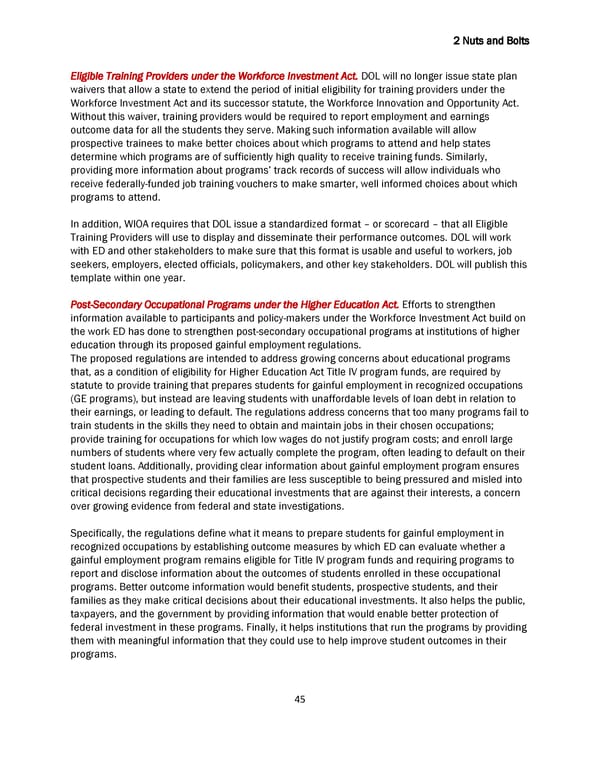2 Nuts and Bolts Eligible Training Providers under the Workforce Investment Act. DOL will no longer issue state plan waivers that allow a state to extend the period of initial eligibility for training providers under the Workforce Investment Act and its successor statute, the Workforce Innovation and Opportunity Act. Without this waiver, training providers would be required to report employment and earnings outcome data for all the students they serve. Making such information available will allow prospective trainees to make better choices about which programs to attend and help states determine which programs are of sufficiently high quality to receive training funds. Similarly, providing more information about programs’ track records of success will allow individuals who receive federally-funded job training vouchers to make smarter, well informed choices about which programs to attend. In addition, WIOA requires that DOL issue a standardized format – or scorecard – that all Eligible Training Providers will use to display and disseminate their performance outcomes. DOL will work with ED and other stakeholders to make sure that this format is usable and useful to workers, job seekers, employers, elected officials, policymakers, and other key stakeholders. DOL will publish this template within one year. Post-Secondary Occupational Programs under the Higher Education Act. Efforts to strengthen information available to participants and policy-makers under the Workforce Investment Act build on the work ED has done to strengthen post-secondary occupational programs at institutions of higher education through its proposed gainful employment regulations. The proposed regulations are intended to address growing concerns about educational programs that, as a condition of eligibility for Higher Education Act Title IV program funds, are required by statute to provide training that prepares students for gainful employment in recognized occupations (GE programs), but instead are leaving students with unaffordable levels of loan debt in relation to their earnings, or leading to default. The regulations address concerns that too many programs fail to train students in the skills they need to obtain and maintain jobs in their chosen occupations; provide training for occupations for which low wages do not justify program costs; and enroll large numbers of students where very few actually complete the program, often leading to default on their student loans. Additionally, providing clear information about gainful employment program ensures that prospective students and their families are less susceptible to being pressured and misled into critical decisions regarding their educational investments that are against their interests, a concern over growing evidence from federal and state investigations. Specifically, the regulations define what it means to prepare students for gainful employment in recognized occupations by establishing outcome measures by which ED can evaluate whether a gainful employment program remains eligible for Title IV program funds and requiring programs to report and disclose information about the outcomes of students enrolled in these occupational programs. Better outcome information would benefit students, prospective students, and their families as they make critical decisions about their educational investments. It also helps the public, taxpayers, and the government by providing information that would enable better protection of federal investment in these programs. Finally, it helps institutions that run the programs by providing them with meaningful information that they could use to help improve student outcomes in their programs. 45
 Biden Ready to Work White Paper 7/22/14 Page 44 Page 46
Biden Ready to Work White Paper 7/22/14 Page 44 Page 46